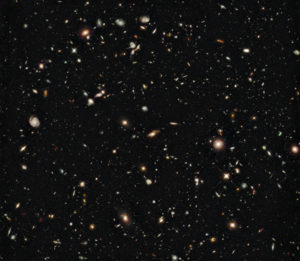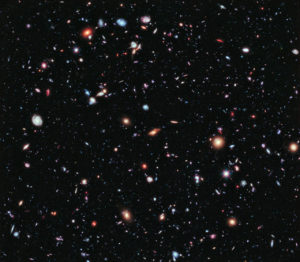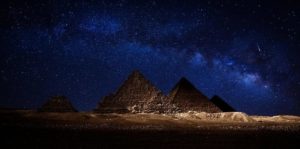Our Solar System
To begin with, our Solar System (our Sun, planets, moons, etc.) is estimated to be at least 80 Astronomical Units (AUs) in diameter, or about 7.5 billion miles across. One (1) AU equals the distance between the center of the Earth and the center of the Sun (or about 93 million miles). Of course, the Earth’s distance to the Sun is not a constant distance because our orbit around the Sun is not perfectly round. But, we can say on the average, it is “about 93 million miles from the Earth to our Sun.”
Furthermore, while astronomers estimate our Solar System is at least 80 AUs across (a diameter of about 7.5 billion miles), this distance is a low estimate because of the orbital dynamics of the planets in our System. That is, the estimated diameter is variable (it is a dynamic distance). Depending on the positions of the planets in their individual orbits, the distance can vary between 80 and more than 100 Astronomical Units. Regardless, we are told our solar system is a mere speck located inconspicuously within the greater Milky Way Galaxy, our parent galaxy.
Our Milky Way Galaxy
Astronomers and cosmologists describe the Milky Way Galaxy as a barred spiral galaxy. That means it has several distinct arms (in our case four) and is shaped in a spiral …like a giant frisbee. When we look up into the dark night sky, all the stars we see with our naked eyes are located within our Milky Way Galaxy. That is, all we can see are the stars within to our Milky Way Galaxy.
In size, the Milky Way Galaxy is about 100,000 light-years (LYs) across. So, what does that really mean? Well, it means it would take light 100,000 years to travel across the full diameter of the Milky Way Galaxy. Consider this, Light travels at 186,000 miles per second. At the mere click of a light switch (i.e.; one second), unblocked light will travel the equivalent distance of approximately 7.5 time around the entire circumference of the Earth …just one second! At a constant speed of 186,000 miles per second, it would take light 100,000 years to cross the full diameter of the Milky Way Galaxy. Over the space of only one-year, light travels 5.88 trillion miles. Therefore, one (1) Light Year (LY) is 5.88 trillion miles. Multiply that by 100,000!
Now, I mentioned that when you look up into the night sky, all the stars you see are within our Milky Way Galaxy. However, still with your naked eyes, you may be able to spot another galaxy …located well outside of the Milky Way! On a clear, dark, moonless night, you may be able to see a small hazy image of a distant galaxy. That would be the Andromeda Galaxy, a big brother to our Milky Way Galaxy, and our nearest independent neighboring galaxy. The Andromeda Galaxy is located about 2.5 million light-years away. And, it is more than twice the size of our Milky Way Galaxy (Andromeda is about 220,000 LYs in diameter).
Our “Observable” Universe
One more point: Among galaxies, our Milky Way Galaxy is just a medium size galaxy. Cosmologists estimate the “Observable Universe” contains at least 2 Trillion Galaxies and “more Stars than the total number of grains of sand on the entire Earth.” By definition, the “Observable Universe” is a spherical region of the universe comprising all matter that can be observed at the present time from Earth or from its space-based telescopes and exploratory probes. This observable universe is estimated to be 93 Billion LYs across. And again, that is only what we can observe. It’s fare to ask, “what exists beyond our limits?” We do not know! This must make you stop, pause, and think!
While you “pause and think,” please consider these scriptural references that refer to the enormous expanse of God’s Creations:
“That in blessing I will bless thee, and in multiplying I will multiply thy seed as the stars of the heaven, and as the sand which is upon the seashore.”
Genesis 22:17
“And thou saidst, I will surely do thee good, and make thy seed as the sand of the sea, which cannot be numbered for multitude.”
Genesis 32:12
“But behold, and lo, we saw the glory and the inhabitants of the telestial world, that they were as innumerable as the stars in the firmament of heaven, or as the sand upon the seashore.”
D&C 76:109
“And there are many kingdoms; for there is no space in the which there is no kingdom;….”
D&C 88:37
“And worlds without number have I created….”
Moses 1:33
“And were it possible that man could number the particles of the earth, yea, millions of earths like this, it would not be a beginning to the number of thy creations; and thy curtains are stretched out still; and yet thou art there….”
Moses 7:30
The Hubble Telescope
Frankly, the numbers in astronomy are too large to get our heads around. We are incapable of understanding the big numbers like “93 Billion Light Years across the expanse of the Universe.” So, how do we calculate and come up with these numbers? Enter the Hubble Deep Space Field Telescope. This powerful satellite-based telescope looked into a patch of sky that looked empty (just above the Big Dipper). It kept the lens open for 10 consecutive days during Christmas 1995 and found about 3,000 additional galaxies (in that “empty space”). Then, in 2004, the Hubble Ultra Deep Space Field Telescope looked into another patch of sky that looked entirely empty. That event represents the deepest portrait of the visible universe ever achieved by humankind. Using the improved capabilities of the Advanced Camera for Surveys (the camera installed during the 2002 servicing mission), a new Deep Field was observed in the constellation of Fornax (the Furnace). The Ultra Deep Field shows the furthest away galaxies that can be observed in visible light. It kept the lens open for 11 days and found about 10,000 additional galaxies there — all these in patches of space that initially looked empty!
(If you would like to see a short video about the origins of the Hubble Telescope, please click on this link: the Hubble Telescope. I apologize, but it may begin with a brief political clip or advertisement. When you finish the Hubble video, please close the YouTube tab to return to this page. Thank you.)

The next breakthrough came after the 2009 servicing mission in which astronauts installed a new instrument capable of making greatly improved infrared observations. The resulting image, covering most of the field of view of the 2004 Ultra Deep Field observations, is the deepest image ever made of the cosmos.
Published in 2012, the Hubble eXtreme Deep Field is not a new set of observations, but rather a combination of many existing exposures (over 2000 of them) into one image. Combining the Hubble Ultra Deep Field, the Hubble Ultra Deep Field – Infrared, and many other images of the same small spot of the sky taken over almost 10 years, the Hubble eXtreme Deep Field pushes the limit even further.

The last Hubble Ultra Deep Field released in 2014 was observed in the ultraviolet. This image allowed astronomers to study star formation in a region 5 to 10 billion light-years away from us. The study is called the Ultraviolet Coverage of the Hubble Ultra Deep Field (UVUDF) project. The addition of ultraviolet data to the Hubble Ultra Deep Field using Hubble’s Wide Field Camera 3 gives astronomers access to direct observations of regions of unobscured star formation. (Note: The above Hubble imagery and information was taken from the Hubble Space Telescope site.)
Summary
As reference points, here’s a simplified and very brief summary of what we can see or estimate about the “Observable Universe” (what we can see). Let’s think of the “Observable Universe” as being divided into Five Levels or systems moving in the “Observable Universe:”
-
-
- In “Our Solar System,” we have eight (8) planets orbiting around our Sun. Compared with other stars in the Universe, our Sun is considered an “unremarkable” star. Our solar system is located about halfway between the center of the Milky Way Galaxy and the outer edge.
-
-
-
- Our galaxy is “the Milky Way Galaxy.” It is a Spiral Galaxy estimated to be 100,000 Light Years (LYs) in diameter. Within the Milky Way Galaxy, our Solar System is one of more than 400 billion Solar Systems. The Pin Wheel Galaxy (visible in Ursa Major) is much like our Milky Way Galaxy. The Milky Way has an estimate of greater than 400 Billion stars within its boundaries, and there could be as many as 40 billion Earth-sized planets orbiting in the habitable zones of Sun-like stars. There is also an additional 16 orbiting Satellite Galaxies just outside the boundaries of the Milky Way Galaxy.
-

-
-
- Outside the Milky Way Galaxy is our “Local Group of Galaxies.” In this group, there are 54 different galaxies, and it is estimated to be 10 Million LYs across. There are three major galaxies in the “Local Group:” The three largest members of the group (in descending order) are the Andromeda Galaxy, the Milky Way Galaxy, and the Triangulum Galaxy.
-
-
-
-
- Andromeda has an estimated one trillion stars with 25 orbiting Satellite Galaxies outside its boundaries. It is a Barred Spiral Galaxy (like our Milky Way) located about 2.5 Million LYs away. And it is about 220,000 LYs in diameter.
- Milky Way has an estimated 400 billion stars with 16 orbiting Satellite Galaxies outside its boundaries. And it is about 100,000 LYs in diameter.
- Triangulum has an estimated 40 billion stars within its boundaries.
-
-
This Local Group itself is a part of the larger Virgo Supercluster, which may be a part of the Laniakea Supercluster.
-
-
- The “Virgo Supercluster (SC)” is a mass concentration of galaxies containing the Virgo Cluster and our Local Group (which in turn contains the Milky Way and Andromeda galaxies). At least 100 galaxy groups and clusters are located within its diameter of 110 million LYs. The Virgo SC is one of about 10 million superclusters in the observable universe. A 2014 study indicates that the Virgo Supercluster is only a lobe of an even greater supercluster: Laniakea.
- The “Laniakea Supercluster (SC)” is the galaxy supercluster that is home to the Milky Way and approximately 100,000 other nearby galaxies. It encompasses approximately 100,000 galaxies stretched out over 520 million LYs. It has the approximate mass of a hundred thousand times that of our Milky Way galaxy.
-
My Conclusion and A Short Video
So, there’s my inadequate summary. And, as I said at the beginning, “this has to make you pause and think!” For me, I am overwhelmed, greatly humbled …and, at the same time, more aware of my own “nothingness!” “O Lord, how great are thy works!” (Psalm 92:5).
To help better visualize our universe, I have attached a well done Internet YouTube video for viewing. This video gives a good visual representation of the information I presented above. It is a great video with helpful graphics. Please click on the following link and enjoy watching this amazing film. (I’m sorry, but it may begin with a brief political clip or advertisement.) When you finish the video, please close the YouTube tab to return to this page. I would like to share an additional insight concerning the Cosmos. Thank you.
The Universe is Way Bigger Than You Think!
As I said, this video is a great visual representation of the visible universe and the cosmos as currently understood by astronomers. I appreciate science and feel this is a very good graphical portrayal of our enormous universe. I enjoyed the video and hope you did, too.
My Religious Perspective
Please bear with me now as I share my personal testimony and conviction of God’s Great Creation, including the Observable/Visible Universe.
Of course, the above video is a product of scientific and astronomical discoveries. So, as you might suspect, it deliberately omits any reference to the Divine Works of God the Father and His Son, Jesus the Christ. As good as this video is, in my mind it omits the most important element of the creation: it omits any reference to the Divine Creator. From the Holy Scriptures, and by the whisperings of the Holy Spirit, we know that Jehovah (the Lord Jesus Christ), under the direction of His Father (God the Eternal Father) was and is the Lord of the Universe, “the same which looked upon the wide expanse of eternity ” (D&C 38:1). He is the Creator of the Universe and He knows and understands all things. To simply call the creation of the Universe “The Big Bang Theory,” is a gross mischaracterization of the power of God, and it ignores the Divine Creator. Our planet, our Solar System, our Galaxy, the universe and beyond, are all part of His Glorious Creation.
“…all things denote there is a God; yea, even the earth, and all things that are upon the face of it, yea, and its motion, yea, and also all the planets which move in their regular form do witness that there is a Supreme Creator.”
(The Book of Mormon, Alma 30:44)
Of these things I am certain, and I testify they are true. I share them with all who will read this. And, I do it with full confidence and all sincerity. I know for myself they are true. My name is Scott A. Edgar. I consider myself a disciple of Jesus Christ. I am a fellow servant in the Gospel of Jesus Christ.
“I would that ye should remember, and always retain in remembrance, the greatness of God, and your own nothingness, and his goodness and long-suffering towards you, unworthy creatures, and humble yourselves even in the depths of humility, calling on the name of the Lord daily, and standing steadfastly in the faith of that which is to come….”
(The Book of Mormon, Mosiah 4:11)
As I leave these thoughts with you, I also include links below to a great talk offered by Elder Neal A. Maxwell, an Apostle of the Lord Jesus Christ. His address was presented in 2002 and is entitled “Our Creator’s Cosmos.” I highly recommend listening to this presentation. And, I hope you’ll ponder and enjoy his inspiring message. It’s about 35 minutes in length. Please note, during this audio presentation, Elder Maxwell makes several references to visuals and graphics. If you’d like to see the images and read the transcript, please click on and open this link: BYU Religious Studies Center. Thank you.
Footnotes:
-
- “Teachings Concerning The Telestial Glory.” (n.d.). Retrieved from http://emp.byui.edu/SATTERFIELDB/Quotes/Telestial.htm
- The Movements Of The Earth – Maristas Checkpoint. (n.d.). Retrieved from https://sites.google.com/site/maristascheckpoint/home/science-1-eso/contents/uni
- Your Solar System Is Located Near The Milky Way Galaxy? (n.d.). Retrieved from http://science.answers.com/Q/Your_Solar_system_is_located_near_the_Milky_way_gal
- “The Zodiac Of The Stars’ Signs” (chapter 8) | Hogwarts … (n.d.). Retrieved from http://www.hogwartsishere.com/library/book/8128/chapter/8/
- Virgo Supercluster – Wikipedia. (n.d.). Retrieved from https://en.wikipedia.org/wiki/Virgo_Supercluster
- “The Universe is Way Bigger Than You Think.”
https://www.youtube.com/watch?v=Iy7NzjCmUf0&feature=youtu.be - Elder Neal A. Maxwell, “Our Creator and the Cosmos” Audio.
- “Teachings Concerning The Telestial Glory.” (n.d.). Retrieved from http://emp.byui.edu/SATTERFIELDB/Quotes/Telestial.htm
Click HERE to watch an amazing video of Universe Size Comparisons.
Click HERE to Return to Recorded Insights.
